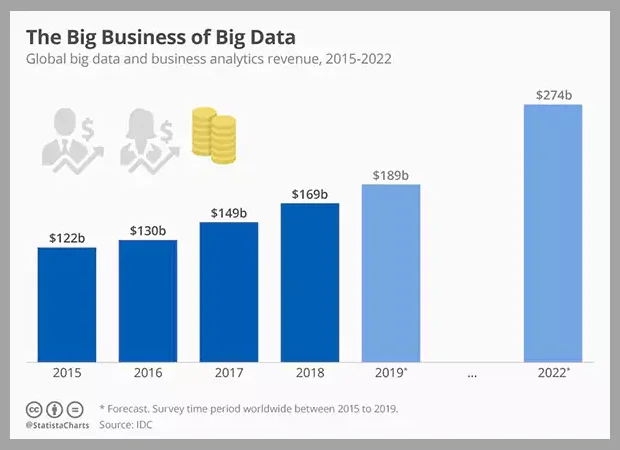
To create evidence-based strategies, analytics has become an integral process in many businesses. It enables storing, organizing, analyzing data, and developing reliable insights for business success. Moreover, companies leverage stats analysis for increased productivity levels and targeted marketing initiatives, thus yielding more returns.
Regardless of what industry your business operates in and the size of your enterprise, it’s necessary to know why analytics is valuable for data-driven growth and how you can leverage it for sustained business success.
For a guided approach, we have prepared this reference for you.
To help you understand how data analytics can help brands thrive, read through its key uses for businesses:
Analytics can also help businesses determine their target markets’ needs, preferences, and purchasing behavior. By utilizing market analysis, they can customize their commodities through these patterns. For instance, in the lending industry, they can track customer behavior on their mobile applications and websites.
So if many clients mostly have queries on “what is a home equity loan,” among many other credit-related entries, they can customize product recommendations and marketing suggestions, focusing on their offerings.
In addition, the more they know about their target market, the more brands can satisfy their consumers, keep them happy, and retain them. One of the main benefits of data analytics is improved user experience (UX) and customer experience (CX).
By gaining access to information on customer transactions, interactions, and profiles, companies can personalize consumer experiences, predict overall satisfaction, and launch merchandise that they would prefer.
To give a concrete example, hospitality businesses analyze guest information like booking history and feedback to recommend personalized offerings like room options, activities, and amenities.
DO YOU KNOW
Data-driven organizations have 23 times more probability to acquire customers, 6 times more to retain customers, and 19 times hopefully to be more profitable.
To be called a “successful” and “innovative” business, you must be able to launch a new or unique product quickly. With the help of detailed reports, brands can monitor the changes in the market and conceptualize new products and services based on growing consumer demands.
To better understand the features that your consumer wants, you can measure purchase frequency among high-priority customer segments. In addition, many successful businesses like Netflix, Uber, and Google leverage information to monitor how their consumers use their products and make necessary changes.
With data analytics, companies can avoid wasting time in misguided advertising campaigns, inefficient operations, and ineffective strategies, among many other time-consuming mistakes. Rather than depending on experimental information, businesses can rely on data-driven decision-making models that can help them identify opportunities more accurately.
However, it’s relevant to know that the patterns yielded by the analysis could have flaws, so it’s significant to do audits and evaluations on the insights and compare them against the original content.
Moreover, market evaluation enables businesses to monitor online shopping, evaluate point-of-sale transactional stats, and analyze user trends. Through these, brands can create campaigns and boost their overall marketing efforts.
It allows enterprises to practice customer-oriented promotions, boosting brand loyalty and continuously meeting and exceeding their expectations.
When using Analytics, ensure you have identified the key performance indicators (KPI) that will help you monitor your progress toward your goals. These metrics may come in the form of conversion rates, click-through rates, lifetime value, customer acquisition cost, or return on ad spend, among many others.
Afterward, you must collect descriptive reports about your target market and distribution channels. From there, you can decide on your campaign material and A/B test them to see if your message resonates with your target market.
Lastly, you must monitor the campaign results and identify what’s working and not working in your campaigns. With the stats derived from monitoring your performance metrics, you can refine or revise messaging, optimize your advertising mix, and focus your resources on the most effective channels. For instance, you may analyze social media engagements, email open rates, and website traffic to identify which channels drive more leads and conversions.
Analytics also allows businesses to optimize their products and services by collecting customer information and feedback. Being aware of what users think about their commodities, brands can identify which areas of operations lead to the best results and which are inefficient and underperforming, allowing them to develop data-driven solutions.
They can also determine if the existing operations are draining the budget, burdensome, or complicated to use. They can proactively anticipate problems, make adjustments, and make necessary improvements for better merchandise.
With this, enterprises can strategize future investments smartly and can accelerate their digital efforts once they transition from manual workflows to automated processes.
Besides collecting user information and feedback and analyzing themes, market evaluation can also help enterprises keep track of their competitors’ activities so they can keep up and identify product or service gaps. This way, they can update their commodities and remain competitive in the fierce market they belong in.
Businesses can also monitor changes in consumer demands and adjust promotional strategies and customer services based on the available reports. For instance, they can measure purchase frequency and understand what they need. Thus, they can also develop prototypes, models of products, and service concepts and test their offerings in the market.
Cybersecurity threats have increased during the COVID-19 pandemic. It has prompted business leaders to take action to minimize, if not eliminate, these risks. These risks include account takeover and fraud, among many other common cybersecurity threats.
Based on research, integrating stats in the risk management process is becoming more critical than ever. Enterprises leverage data analytics to identify, prioritize, mitigate, monitor, and report these threats so organizations can develop workable solutions.
It can be done through the analytical models that data scientists have conceptualized and produced. These models can identify potential risks, assess their impact, and evaluate the strategic and financial implications against the investment, allowing brands to manage associated risks.
Moreover, more stats come with increased risk around data usage compliance and privacy. So, it’s now significant for large companies that access internal and third-party reports to install risk management analytics for data protection of their reputation, assets, and consumers.
Any suspicions regarding the relevance of big data analytics will diminish by looking at the graph below. It shows the interest of industries in data analysis is growing every year.

There are many reasons why employees would leave their current jobs. But, in most cases, employees resign because they find another option with more favorable conditions. That’s why business leaders proactively retain their top talents through improved employee engagement.
Using modern HR platforms, managers can use big data to increase retention and boost employee productivity. According to research, a Human Resource Management System (HRMS) integrated with enterprise stats can result in better employee engagement and performance. More than these, it boosts organizational recruitment, training, personnel, and salary management.
Many enterprises have cast stats repositories and have reached a point where they no longer know what to do with this wealth of information. With data analytics, they can use reports collected and translate them into logical decisions for improved business management. This way, company leaders can become data-driven individuals who can make decisions that benefit the entire organization.
